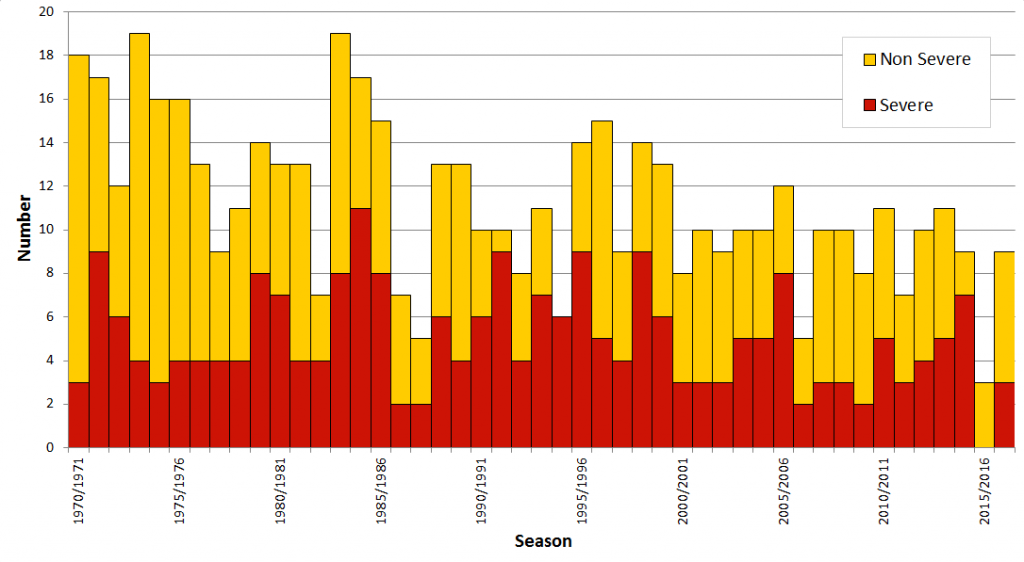Tropical storms in the Pacific are strongly influenced by solar activity fluctuations and ocean cycles
By Dr. Sebastian Lüning and Prof. Fritz Vahrenholt
(German text translated/edited by P Gosselin)
Tropical storms have plagued humans since the start. Today we will shed some light on the activity pattern of the Pacific region. Toomey et al. 2016 examined tropical storm activity in the Ssouth Pacific for the past 3000 years.
Conclusion: During the period from 2600 to 1500 years before today storms were at their worst. What follows is an excerpt from the paper’s abstract:
Our companion record of tropical cyclone activity from Tahaa suggests major storm activity was higher between 2600-1500 years B.P., when decadal scale SPCZ variability may also have been stronger. A transition to lower storm frequency and a shift or expansion of the SPCZ [South Pacific Convergence Zone] toward French Polynesia around 1000 years B.P. may have prompted Polynesian migration into the central Pacific.”
In the Western North Pacific it was discovered that cyclonic storm activity was surprisingly strongly coupled to the Atlantic Multidecadal Oscillation (AMO). In February 2018 Zhang et al. reported:
Dominant Role of Atlantic Multidecadal Oscillation in the Recent Decadal Changes in Western North Pacific Tropical Cyclone Activity
Over the 1997–2014 period, the mean frequency of western North Pacific (WNP) tropical cyclones (TCs) was markedly lower (~18%) than the period 1980–1996. Here we show that these changes were driven by an intensification of the vertical wind shear in the southeastern/eastern WNP tied to the changes in the Walker circulation, which arose primarily in response to the enhanced sea surface temperature (SST) warming in the North Atlantic, while the SST anomalies associated with the negative phase of the Pacific Decadal Oscillation in the tropical Pacific and the anthropogenic forcing play only secondary roles. These results are based on observations and experiments using the Geophysical Fluid Dynamics Laboratory Forecast-oriented Low-ocean Resolution Coupled Climate Model coupled climate model. The present study suggests a crucial role of the North Atlantic SST in causing decadal changes to WNP TC frequency.”
In September 2017 Takahashi et al. had assumed that here sulfate aerosol emissions may have played a role. The explanation of the AMO presented by Zhang et al. probably makes more sense because ocean cycles are gaining greater importance as a climate factor in the attribution by observed natural climate variability.
Next we go on to Australia. Dowdy 2014 showed that the frequency of tropical storms had declined. Moreover it appears that El Nino is a variable. This is also confirmed by a chart of the Australian Bureau of Meteorology:

Graph showing the number of severe and non-severe tropical cyclones from 1970-2017 which have occurred in the Australian region. Severe tropical cyclones are shown here as those with a minimum central pressure less than 970 hPa. Source: Bureau of Meteorology
Haig & Nott 2016 investigated the development of Australian tropical storms over the past 1500 years and here found an impact by solar activity fluctuations:
Solar forcing over the last 1500 years and Australian tropical cyclone activity
Accurate seasonal and decadal predictions of tropical cyclone activity are essential for the development of mitigation strategies for the 2.7 billion residents living within cyclone prone regions. The traditional indices (Southern Oscillation Index and various sea surface temperature indices) have fallen short in recent years as seasonal predictors within the Australian region. The short length of these records (i.e., <50 years) has meant that our current knowledge of larger-scale drivers at interdecadal, centennial, and millennial scales is limited. The development of a new tropical cyclone activity index spanning the last 1500 years has enabled the examination of tropical cyclone climatology at higher temporal resolution than was previously possible. Here we show that in addition to other well-known climate indices, solar forcing largely drives decadal, interdecadal, and centennial cycles within the tropical cyclone record.”





It’s that big fusion reactor in space that is to blame.
Not Man’s trivial CO2 emissions, despite what “consensus science” and the retarded MSM would have us believe.
B&t – yes, that is why the Greens want to ban nuclear power – its just like the sun! /sarc
YEP,
“Here we show that in addition to other well-known climate indices, solar forcing largely drives decadal, interdecadal, and centennial cycles within the tropical cyclone record.”
The ridiculously insubstantial human generated atmospheric CO2 can not control these cycles, just like CO2 levels do not regulate the jet-stream, or weather variations, sea-levels, extinction of species, planetary ice sheet levels, or the Earth’s climate, these are wholly natural phenomena.
Humans could affect any or all of these phenomena but NOT through our extremely merger output of atmospheric CO2.
[…] https://notrickszone.com/2018/03/04/mans-small-role-new-scientific-findings-show-pacific-tropical-sto… […]